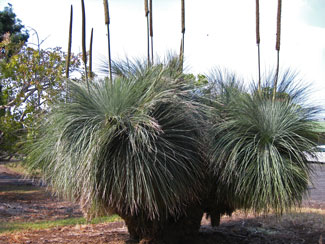Resource Library
Plant of the Week: Grasstree
The University of Arkansas System Division of Agriculture does not promote, support or recommend plants featured in "Plant of the Week." Please consult your local Extension office for plants suitable for your region.
Plant of the Week
Grasstree
Latin: Xanthorrhoea preissii

For more than 30 years I taught a course at the U of A about houseplants, bulbs and herbaceous garden plants. Because there are thousands of plants that fall into each of these categories, I chose to emphasize plant families and consider a few of the most important species within each family.
I still believe in the usefulness of understanding plant families because cultural requirements, pests, growth habits and identifying characteristics can usually be approximated within a particular family. The lily family always seemed overly large and a bit squishy around the edges but I stuck with it for simplicity’s sake. Modern taxonomic treatment has blown this dear old family to smithereens. I now find that daylilies and aloes, two of the plants I used to cover, belong to a family I’ve never heard of, the Xanthorrhoeaceae.
The Xanthorrhoeaceae, or grasstree family, is an old family that was at one time home to the 28 or so Australian endemics that make up the group. In 2009, an international body of botanists expanded the family to include two short-lived plant families that are now treated as subfamilies; the asphodels which include aloe, red hot pokers, bulbine and many others, and the daylilies which include plants such New Zealand Flax and about 20 other genera. The vast majority of these plants are Southern Hemisphere plants with only a few, such as the daylilies, extending into the Asian tropics.
The grasstrees are all native to Australia and grow as unbranched, or sparsely branched, trees to 10 feet tall with a topknot of 3-foot-long narrow, tough-textured, blue-green leaves. The trunks can be a foot or more across and are hollow with the outer ring of the trunk formed from old leaf bases while the inner core of the hollow contains roots that support the top growth of the plant.
The flowers are not especially showy but are borne on a 10-foot-tall unbranched scape that extends above the foliage like so many tall birthday candles. Plants are exceedingly slow growing with 10 years required to achieve a plant with a 2-inch stem and leaves to a couple feet long. In nature, they often exceed 600 years of age. The well-branched specimen accompanying this article is Xanthorrhoea preissii that was photographed on the Big Island of Hawaii.
An easy question to ask but not so easy to answer, is just how did the grasstree family come to house some of our most beloved garden plants? Naming and classifying plants has been an interesting exercise for thousands of years. Early attempts at classification were focused on the utility of plants to humankind but over time there evolved the system of identifying plants based on a set of observable characteristics. Linnaeus, the father of modern taxonomic botany, tried to classify plants based on a dozen or so observable characteristics of the flower. This quickly proved inadequate and many other observable traits were added over the years though the Linnaean system of nomenclature still remains in place.
Today over 40 physical traits are used to describe species but even that number is often expanded when delineation between closely related plants comes into play. Many of these traits are based on obscure points involving how the cells divide or the early stages of seed development, characteristics that can only be seen using the microscope. These data points are then added to a spread sheet and computer technology quickly finds associations that mere mortals could easily miss. Add to that the recent advances in DNA analysis and old, easily discernible characteristics used to classify plants have been blown asunder.
Another factor to be added into the mix of reason for the changes is internationalization. No longer is the decision for classification based on the work of one introverted researcher working in the basement of some old campus building, but instead experts from throughout the world are brought together by the Internet to work out thorny issues and come to a consensus. The umbrella organization for the reclassification that is going on is a group of scientists called the Angiosperm Phylogeny Group which meets periodically and updates its findings.
The latest revision, APG III, was in 2009. Because their work is web-based, book publishers no longer have a vested interest in preserving the status quo by maintaining traditional classification schemes. As these scientists work through the million or so plants in the world and apply the latest techniques of classification that build on the principle of seeking out threads of common ancestry, many more changes will appear in the garden world. Eventually all these changes will make sense, but in the meantime, change is hard.
By: Gerald Klingaman, retired
Retired Extension Horticulturist - Ornamentals
Extension News - April 5, 2013
The University of Arkansas System Division of Agriculture does not maintain lists of retail outlets where these plants can be purchased. Please check your local nursery or other retail outlets to ask about the availability of these plants for your growing area.